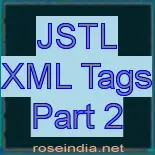JSTL XML Tag Part 2
demo4 is a simple
variation on the same theme. In this case, the user selects the author name from
the combo and any books by that author are displayed, due to the code.
It will be noted that 'allaire' has two books
to his credit and so if we choose 'allaire' in the combo,his two books are
displayed.If 'haris' is chosen, we should display the message that it is yet to
be published as there is no such entry in the xml file. But there is no
'if-else' construct and so we improvise.
We have created a variable 'a' and assigned the value 'ok'
to it. If there is no author to match the user's selection, the conditional
block is ignored and 'a' will not be 'ok'.
From this, we conclude that 'the book is not ready'.
----------------------------------
demo4.htm
<html>
<body>
Select name of author & view his books<br>
<form method=post action="demo4.jsp">
<select name="combo1">
<option value="morrison">morrison
<option value="robert">robert
<option value="allaire">allaire
<option value="herbert">herbert
<option value="roy">roy
<option value="haris">haris
</select>
<input type=submit>
</form>
</body>
</html>
==============
demo4.jsp
========
<%@ page contentType="text/html" %>
<%@ taglib prefix="c"
uri="http://java.sun.com/jstl/core" %>
<%@ taglib prefix="c"
uri="http://java.sun.com/jstl/xml" %>
<html>
<body>
<c:import
url="books.xml" var="url" />
<x:parse
xml="${url}" var="doc" />
<c:set
var="s"
value="${param.combo1}"/>
<x:forEach var="n" select="$doc/books/book" >
<x:if
select="$n/author=$s" >
<c:set var="a" value="ok" />
<x:out
select="$n/title" />
<br>
<x:out select="$n/author" />
<br>
</x:if>
</x:forEach>
<c:if
test="${a!='ok'}" />
<c:out value="not
yet ready!"
/>
</c:if>
</body>
</html>
===============================================
In
demo5 also, we display the title & author for a given title,
but we now use <x:choose, <x:when logic. This is similar to <c:choose,
<c:when & <c:otherwise logic in the core library.
----------------------------------------------
demo5.htm
<html>
<body>
SELECT THE
TITLE.<BR>
YOU WILL GET TITLE &
AUTHOR.
<form method=post
action="demo5.jsp">
<select name="combo1">
<option value="xml unleashed">xml
<option value="c++">c++
<option value="coldfusion">cold fusion
<option value="java">java
<option
value="cobol">cobol
</select>
<input type=submit>
</form>
</body>
</html>
-----------
demo5.jsp
<%@ page contentType="text/html" %>
<%@ taglib prefix="c"
uri="http://java.sun.com/jstl/core" %>
<%@ taglib prefix="c"
uri="http://java.sun.com/jstl/xml" %>
<html>
<body>
<c:import url="books.xml"
var="url" />
<c:set var="s" value="${param.combo1}"
/>
<x:parse xml="${url}"
var="doc" />
<x:forEach var="n"
select="$doc/books/book">
<x:choose>
<x:when select="$n/title=$s">
<x:out select="$n/title" />
</x:when>
<x:otherwise>
</x:otherwise>
</x:choose>
<c:if
test="${m!='ok'}">
<c:out
value="no such book"/>
</c:if>
</body>
</html>
Result
--------------------
title sent
from user:
c++
--------------------
c++
robert
========================-
title
sent from user:
VB
--------------------
no such
records
***************************************
In demo6 , we see XSLtransform using
JSTL.
-----------------------------------------------
<%@ taglib prefix="c"
uri="http://java.sun.com/jstl/core" %>
<%@ taglib prefix="x"
uri="http://java.sun.com/jstl/xml" %>
<c:import
url="students.xml"
var="url" />
<c:import url="xsl1.xsl"
var="xsl" />
<x:transform xml="${url}" xslt="${xsl}" />
-----------------------------------------------
// students.xml
<?xml version="1.0"?>
<students>
<student>
<name>Thomas</name>
<place>Delhi</place>
<number>1111</number>
<mark>78</mark>
</student>
<student>
<name>David</name>
<place>Bombay</place>
<number>4444</number>
<mark>90</mark>
</student>
<student>
<name>Mathew</name>
<place>Bangalore</place>
<number>5555</number>
<mark>92</mark>
</student>
<student>
<name>John</name>
<place>Hyderabad</place>
<number>6666</number>
<mark>72</mark>
</student>
</students>
-----------------------------------------------
xsl1.xsl
=======
<?xml version="1.0"?>
<xsl:stylesheet
xmlns:xsl="http://www.w3.org/1999/XSL/Transform" version="1.0">
<xsl:template match="/">
<html>
<body>
<table border="2"
bgcolor="yellow">
<tr>
<th>Name</th>
<th>Place</th>
<th>Number</th>
<th>Mark</th>
</tr>
<xsl:for-each select="students/student">
<tr>
<td><xsl:value-of
select="name"/> </td>
<td><xsl:value-of
select="mark"/> </td>
</tr>
</xsl:for-each>
</table>
</body>
</html>
</xsl:template>
</xsl:stylesheet>
---------------------------------------------
|
Name |
Place |
Number |
Mark |
|
Thomas |
Delhi |
1111 |
78 |
|
David |
Bombay |
4444 |
90 |
|
Mathew |
Bangalore |
5555 |
92 |
|
John |
Hyderabad |
6666 |
72 |
===============================================
That completes our study of 'xml' tags in JSTL.We now move
ahead to the fourth and final part of the present tutorial, dealing with 'sql'
tags in JSTL.
